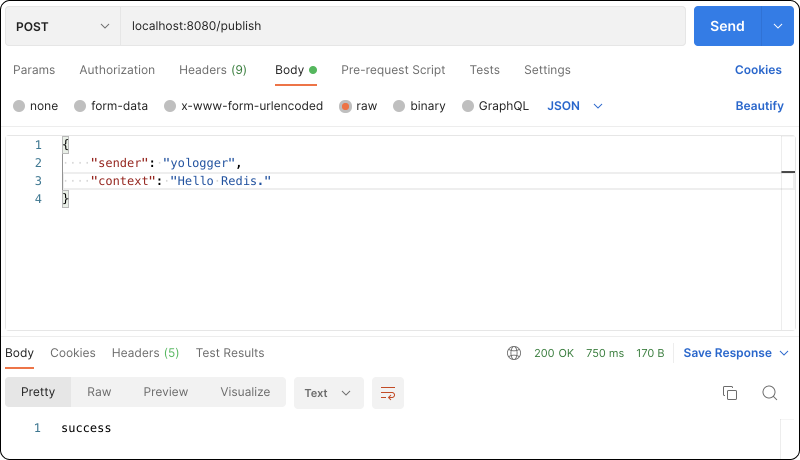# Spring Boot with Redis Pub/Sub
Spring Boot 프로젝트에서 Redis Pub/Sub을 사용하는 방법에 대해 정리한다. 예제는 다음과 같이 두 개의 프로젝트로 구성된다.

우선 Redis 서버를 구동하자.
$ brew services start redis
$ brew services list
Name Status User File
redis started yologger ~/Library/LaunchAgents/homebrew.mxcl.redis.plist
# Subscriber
채널을 구독하는 Subscriber 프로젝트는 다음과 같다.
# application.yml
server:
port: 9090
spring:
redis:
host: localhost
port: 6379
MessageListener의 구현체는 채널을 구독하는 컴포넌트다.
import com.fasterxml.jackson.databind.ObjectMapper;
import lombok.RequiredArgsConstructor;
import org.springframework.data.redis.connection.Message;
import org.springframework.data.redis.connection.MessageListener;
import org.springframework.stereotype.Service;
import java.io.IOException;
@Service
@RequiredArgsConstructor
public class RedisSubscriber implements MessageListener {
@Override
public void onMessage(Message message, byte[] pattern) {
try {
ObjectMapper mapper = new ObjectMapper();
ChatMessage chatMessage = mapper.readValue(message.getBody(), ChatMessage.class);
System.out.println("sender: " + chatMessage.getSender());
System.out.println("context: " + chatMessage.getContext());
} catch (IOException e) {
e.printStackTrace();
}
}
}
이제 Redis 구성파일에 MessageListener의 구현체를 등록한다.
import org.springframework.context.annotation.Bean;
import org.springframework.context.annotation.Configuration;
import org.springframework.data.redis.connection.RedisConnectionFactory;
import org.springframework.data.redis.connection.lettuce.LettuceConnectionFactory;
import org.springframework.data.redis.core.RedisTemplate;
import org.springframework.data.redis.listener.ChannelTopic;
import org.springframework.data.redis.listener.RedisMessageListenerContainer;
import org.springframework.data.redis.listener.adapter.MessageListenerAdapter;
import org.springframework.data.redis.serializer.StringRedisSerializer;
@Configuration
public class RedisConfig {
@Bean
public RedisConnectionFactory redisConnectionFactory() {
return new LettuceConnectionFactory();
}
@Bean
public RedisTemplate<String, Object> redisTemplate() {
RedisTemplate<String, Object> redisTemplate = new RedisTemplate<>();
redisTemplate.setConnectionFactory(redisConnectionFactory());
redisTemplate.setKeySerializer(new StringRedisSerializer());
return redisTemplate;
}
// 채널 등록
@Bean
ChannelTopic topic() {
return new ChannelTopic("channel1");
}
// MessageListener의 구현체 등록
@Bean
public MessageListenerAdapter messageListenerAdapter(RedisSubscriber redisSubscriber) {
return new MessageListenerAdapter(redisSubscriber);
}
// MessageListener의 구현체와 채널 연결
@Bean
public RedisMessageListenerContainer redisMessageListenerContainer(RedisConnectionFactory redisConnectionFactory, MessageListenerAdapter messageListenerAdapter, ChannelTopic topic) {
RedisMessageListenerContainer container = new RedisMessageListenerContainer();
container.setConnectionFactory(redisConnectionFactory);
container.addMessageListener(messageListenerAdapter, topic);
return container;
}
}
# Publisher
채널로 메시지를 발행하는 Publisher 프로젝트는 다음과 같다.
# application.yml
server:
port: 8080
spring:
redis:
host: localhost
port: 6379
Redis 구성파일은 다음과 같다.
// RedisConfig.java
import org.springframework.context.annotation.Bean;
import org.springframework.context.annotation.Configuration;
import org.springframework.data.redis.connection.RedisConnectionFactory;
import org.springframework.data.redis.connection.lettuce.LettuceConnectionFactory;
import org.springframework.data.redis.core.RedisTemplate;
import org.springframework.data.redis.serializer.Jackson2JsonRedisSerializer;
import org.springframework.data.redis.serializer.StringRedisSerializer;
@Configuration
public class RedisConfig {
@Bean
public RedisConnectionFactory redisConnectionFactory() {
return new LettuceConnectionFactory();
}
@Bean
public RedisTemplate<String, Object> redisTemplate() {
RedisTemplate<String, Object> redisTemplate = new RedisTemplate<>();
redisTemplate.setConnectionFactory(redisConnectionFactory());
redisTemplate.setKeySerializer(new StringRedisSerializer());
redisTemplate.setValueSerializer(new Jackson2JsonRedisSerializer<>(ChatMessage.class));
return redisTemplate;
}
}
메시지로 사용할 데이터 클래스는 다음과 같다.
@Getter
@NoArgsConstructor
@AllArgsConstructor
public class ChatMessage {
private String sender;
private String context;
}
채널로 메시지를 전송하는 서비스 컴포넌트는 다음과 같이 구현한다.
// RedisPublisher.java
import lombok.RequiredArgsConstructor;
import org.springframework.data.redis.core.RedisTemplate;
import org.springframework.stereotype.Service;
@Service
@RequiredArgsConstructor
public class RedisPublisher {
private final RedisTemplate<String, Object> redisTemplate;
public void sendMessage(ChatMessage chatMessage) {
redisTemplate.convertAndSend("channel1", chatMessage);
}
}
마지막으로 클라이언트를 위한 REST API 엔드포인트를 다음과 같이 구성한다.
// RedisController.java
import lombok.RequiredArgsConstructor;
import org.springframework.web.bind.annotation.PostMapping;
import org.springframework.web.bind.annotation.RequestBody;
import org.springframework.web.bind.annotation.RestController;
@RestController
@RequiredArgsConstructor
public class RedisController {
private final RedisPublisher redisPublisher;
@PostMapping("/publish")
public String publish(@RequestBody ChatMessage chatMessage) {
redisPublisher.sendMessage(chatMessage);
return "success";
}
}
# 결과 확인
이제 HTTP Client(Postman)로 Publisher에 요청을 보내보자.

Subscriber 로그에 메시지가 출력되는 것을 확인할 수 있다.

